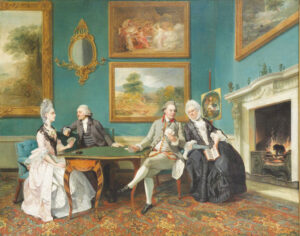 Cleveland, October 19, 2023: Recent acquisitions by the Cleveland Museum of Art (CMA) continue to add to the quality of the collection and to expand its depth and breadth. Visitors will soon be able to view a masterpiece by Johann Zoffany and important watercolors by Eugène Delacroix and Emma Amos.
Cleveland, October 19, 2023: Recent acquisitions by the Cleveland Museum of Art (CMA) continue to add to the quality of the collection and to expand its depth and breadth. Visitors will soon be able to view a masterpiece by Johann Zoffany and important watercolors by Eugène Delacroix and Emma Amos.
The Dutton Family in the Drawing Room of Sherborne Park, Gloucestershire, is a masterpiece by Johann Zoffany, exemplifying the quintessentially English genre of which he was the most accomplished practitioner––the conversation piece. The Dutton family was painted around 1772, at the height of Zoffany’s career. The painting is in extraordinary condition, extensively published, has been a cornerstone of groundbreaking exhibitions, and twice achieved the record price for the artist at auction.
The CMA’s British paintings collection is distinguished primarily by great landscapes, individual portraits, and miniatures but has lacked that linchpin genre, the conversation piece. During the eighteenth century, these informal group portraits flourished among the newly wealthy middle class, for whom the genre provided the opportunity to perform the coded gestures of polite society and showcase the fashionable interiors that attested to their refinement. But the painting is also a timeless testament to that most intimate and complex network of relationships—the family. Conversation pieces give us an intimate glimpse into how British families socialized and decorated—or as importantly—how they wanted to be remembered as living.
The Dutton Family is among the final great conversation pictures remaining in private hands and represents the culmination of Zoffany’s achievements in the genre. This portrait depicts parents socializing with their son and daughter playing cards in a country house. The family is dressed in mourning following the death of a loved one. Executed with his trademark virtuosity and love of significant detail, this family portrait was so treasured by generations of Dutton heirs that it remained in the family collection for more than 150 years.
A Young Black Woman Fetching Water by Eugène Delacroix
Created in a new style consisting of bold colors and subject matter drawn from contemporary life
Eugène Delacroix was among the most influential Romantic artists and, in the late 1820s, began to work on Orientalist images, the depiction of non-Western cultures by European artists. Young Black Woman Fetching Water presents a young Moroccan woman wearing a robe and headdress while holding a burnoose—a long, hooded cloak worn in Arab countries. She was almost certainly an enslaved African; from the Middle Ages, Morocco was a center of the international slave trade and continued to be so until the early twentieth century.
The watercolor is one of eighteen drawings that comprised the so-called “Mornay Album” that the artist made during a diplomatic journey to Spain, Morocco, and Algeria in 1832 with the Count de Mornay, the French ambassador to the Sultan of Morocco. Upon the completion of their travels together, Delacroix selected eighteen of his most prized watercolors and bound them in an album which he gave to de Mornay as a souvenir of their journey. These works are considered Delacroix’s greatest accomplishment in watercolor, a medium in which he was an avid and skilled practitioner. The drawings in the album were dispersed in 1877 in Mornay’s collection sale and are highly coveted today. Delacroix reconsidered the subject of this watercolor in 1834 in the celebrated painting Women of Algiers(Louvre Museum), which later modern artists from Vincent van Gogh to Paul Cezanne and Pablo Picasso each described as a direct inspiration for their work.
The Gift by Emma Amos
One of the African American artist’s most significant artworks
The Gift, one of the most significant works by the African American artist Emma Amos (1937–2020), comprises 48 individual watercolor portraits of women artists, writers, and curators in Amos’s community in New York in the early 1990s. The women pictured belong to different generations and are from a range of racial and ethnic backgrounds. Some of the subjects are well-known and others are not. Regardless of their status, every sitter is treated by Amos with curiosity, care, and attention that reflects the artist’s admiration of each woman she represents.
What motivated the artist to produce this formidable account of female creativity was a desire to make vivid to her daughter, India, the value of friendship and community. She created the work as a gift for India for her twentieth birthday. Especially remarkable for the confluence of ideas and histories that it brings together, The Gift is a manifestation of intergenerational feminist community building. In its content, it documents a particular cultural milieu. And in its form, it is an arresting work of portraiture. The Gift joins signature works in other media by Amos in the CMA’s collection: the painting Sandy and Her Husband, 1973 (2018.24), and the etching and aquatint Without Feather Boa, 1965 (2021.142).

